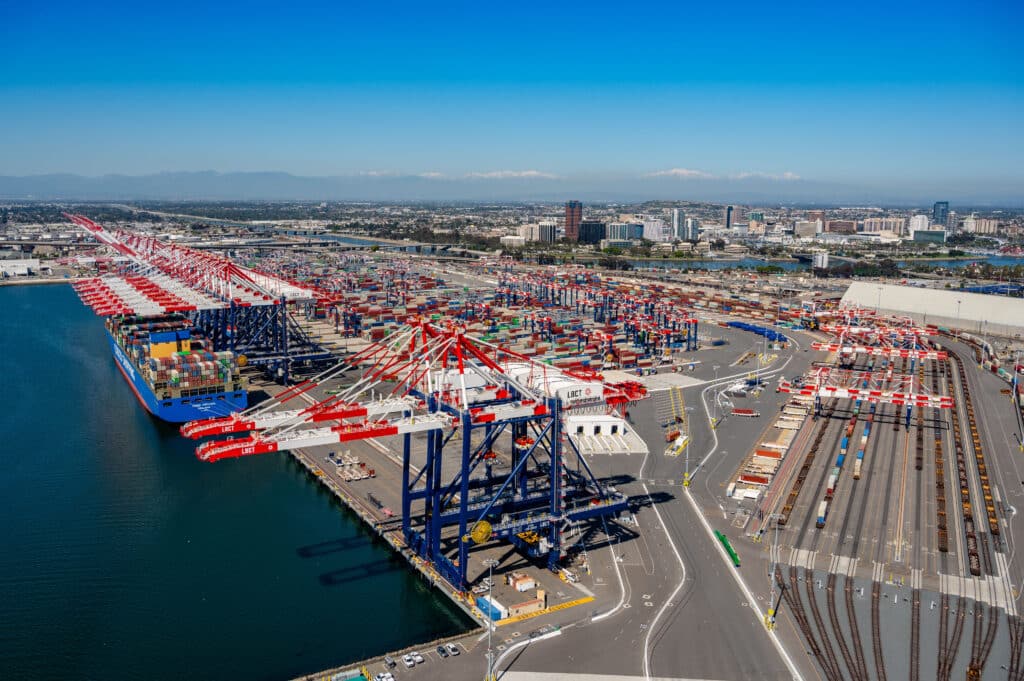Long Beach Container Terminal On Track to Reach Net Zero as Shipments Climb
On January 22, 2025, the Long Beach Container Terminal (LBCT), one of the world’s largest and most advanced cargo handling facilities, announced that it is accelerating its journey to achieving Net Zero emissions by 2030. The terminal has unveiled several significant on-site advancements, reinforcing its commitment to sustainability and showing that economic growth and environmental responsibility can go hand in hand.
One of the most notable steps toward reducing emissions at LBCT is the introduction of electric ship-to-shore cranes. These cranes, which are pivotal in loading and unloading cargo from massive container ships, have been upgraded to electric power, eliminating emissions from diesel-powered operations. In addition, electric rail cranes have been integrated to reduce the environmental impact of rail transport at the terminal.
LBCT is also taking bold strides in its truck fleet, transitioning to a zero-emission terminal truck fleet, and it has constructed a second battery charging and exchange building. These trucks are critical for transporting goods between the terminal and other parts of the logistics chain, and the shift to electric vehicles is expected to significantly cut down emissions from the transportation sector, which is a major contributor to air pollution in port cities.

LBCT’s efforts underscore its belief that a thriving economy and a healthy environment are not mutually exclusive. With these sustainable innovations, the terminal is not only improving operational efficiency but also setting a new standard for the global port industry.
As a major hub for global trade, the Port of Long Beach plays a pivotal role in the global supply chain. However, this high level of activity traditionally comes with a significant environmental footprint, as dirty diesel creates significant environmental harm, and contributes heavily to climate change. LBCT’s initiatives demonstrate that large-scale industrial operations can take bold steps toward sustainability and not only remain economically viable, but offer tremendous cost savings.
The sustainability report released by LBCT today highlights the company’s ongoing progress toward its Net Zero target. The report documents the terminal’s dedication to reducing greenhouse gas emissions, improving air quality, and integrating green technologies that will drive future growth while minimizing environmental impact.
In the coming years, LBCT plans to continue expanding its electric infrastructure and ramp up efforts to replace fossil fuel-based equipment with green alternatives. The facility is also exploring other sustainable technologies, such as renewable energy solutions, to further enhance its commitment to Net Zero.
“LBCT remains an attractive choice for shippers because we have incorporated clean-energy technologies while continuing to have the fastest truck turn times, shortest vessel berth stays, and shortest rail dwell times of any terminal in San Pedro Bay,” said Anthony Otto, LBCT Chief Executive Officer. “We continue to meet or exceed emission regulations, promote safety and create climate resiliency because of the incredible collaborative effort among our workers, the community, our elected officials and our shipping customers and partners.”
LBCT Green Initiatives Create Jobs
LBCT is reinvesting in the community by developing job training programs aimed at equipping local youth with valuable skills. These programs not only contribute to economic mobility but also enable youth to gain hands-on experience with sustainability-focused initiatives, which can open doors to future employment in the expanding field of clean energy and green technologies.
The terminal continues to support local labor by offering well-compensated positions in various sectors, including terminal operations, equipment maintenance, and logistics management. As part of its ongoing commitment to the community, LBCT works closely with unions and local labor organizations to ensure that these jobs offer competitive wages and benefits.
“LBCT cultivates trust among labor partners, with a commitment to training and upskilling the workforce to prepare for a zero-emission future,” said Tommy Faavae, Business Development Manager of IBEW Local 11. “LBCT ensures that any new zero-emission terminal equipment funded in collaboration with the federal government is human-operated and built by American manufacturers.”
Impressive Environmental Impacts
LBCT’s 96% GRESB score reflects its strong commitment to sustainable operations, corporate transparency, and social responsibility. GRESB evaluates organizations across a range of environmental, social, and governance (ESG) criteria. LBCT’s top ranking demonstrates its leadership in the shipping industry and its alignment with the global push toward more sustainable and responsible business practices.
The Net Zero Progress Report also details how LBCT is successfully navigating emission-reduction regulations, positioning itself as an industry leader in the fight against climate change. With a combination of innovative technology and responsible practices, LBCT is setting an example for ports around the world.
A $2.5 Billion Investment in Sustainability
LBCT’s ambitious commitment to zero-emission electric operations has been realized through a $2.5 billion investment in the conversion of its cranes and cargo-handling vehicles. This transformation, which is part of a comprehensive 15-year effort, aims to replace fossil fuel-dependent machinery with advanced electric alternatives to reduce the facility’s carbon footprint.
As of today, LBCT has already achieved a remarkable 86% reduction in greenhouse gas emissions and criteria pollutants. This significant decrease in emissions marks a key milestone in the terminal’s sustainability journey and brings LBCT closer to its ultimate goal of reaching Net Zero emissions by 2030. In addition to environmental benefits, this shift has also led to a quadrupling of cargo-handling capacity, demonstrating that sustainability can go hand in hand with operational growth.
LBCT’s Net Zero infrastructure transition plan will include additional clean-energy initiatives, such as more electric-charging stations, clean-power generation and storage, and working with the Port of Long Beach to advance its Clean Air Action Plan, helping to influence other industries to de-carbonize operations.

Electric Vehicle Marketing Consultant, Writer and Editor. Publisher EVinfo.net.
Services